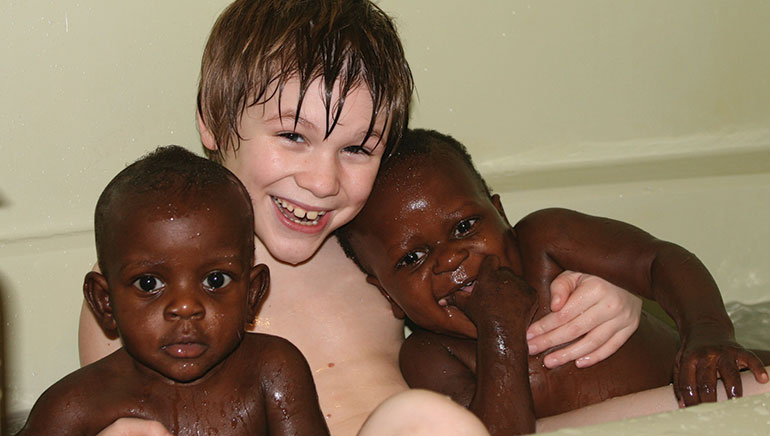When you become the parent of a child who doesn’t share your medical background and you have little or no medical history for his birth parents, it can take time to learn how to care for his skin, scalp, and hair. Every year, as many as 100,000 families in the United States may find themselves in this situation, after adopting a newborn domestically, adopting from foster care, or from another country.
As a board-certified dermatologist, and an adoptive mom who’s active in the adoption community, I’ve seen that there is a real need for education on this topic, especially in transracial families. Keeping your child’s skin and hair clean and healthy is something you will be dealing with on a daily basis in your home, yet it may not have come up at all in your pre-adoption education. I recently published a guidebook, Child of Mine: Caring for the Skin and Hair of Your Adopted Child, hoping that it will become an essential resource that adoptive parents, social workers, hair stylists, and child care providers consult.
All about skin types
There are all kinds of natural variations in human bodies. People differ in height and in the shape and size of their body parts. Another difference among humans is skin color, which our children inherit from their birth parents.
Beyond differences in skin color and phototype, or the skin’s sensitivity to UV ray exposure, we each have another variation in skin type. This has to do with whether our skin is dry, normal, oily, sensitive, or some combination of these. A baby’s, child’s, or teen’s skin is always more sensitive than adult skin, as it is thinner and the sweat and sebaceous glands are less developed. As with skin color, most children will display skin traits similar to their biological parents. If you don’t have information about your child’s birth parents’ skin traits, you should monitor his skin and skin care carefully.
Our children learn to love themselves, including their physical appearance, when we teach them to do so. Show your child how special his skin is. Set aside time to “do skin care” with your child. This nurturing is both physical and emotional. Teach your child that caring for her skin requires time and effort, and is important and worthwhile. Talk about how much you enjoy taking care of her, and be sure to tell her how beautiful she is.
Healthy skin starts with clean skin, which should then be moisturized and protected. The skin care products you use for your child or infant should be age- and skin type-appropriate. You may need to use different products for facial and body skin. Here are my recommendations to get you started on a healthy skin care regimen.
STEP 1: CLEANSE
Cleanse your newborn’s face and body using a soft cloth and a gentle cleanser. Newborns cannot regulate their body temperature well, so it is not uncommon for them to shiver or for their skin to turn a bit blue when they are undressed. Keep this in mind when bathing or changing your infant. Minimize his exposure to cool air, and keep the bathroom warmer than you would for yourself. When bath time is over, bundle your child up for warmth. If your child’s skin does not return to its normal color, or if he seems to shiver constantly, consult your pediatrician. In general, infants and toddlers need one more layer of clothing than adults do.
After your baby’s umbilical stump falls off, and he can start taking baths, these should be no longer than five or 10 minutes with tepid to warm water. Avoid long, hot baths with drying soap, including bubble bath, in order to keep your child’s skin from becoming too dry. Bubble bath can be used as an occasional treat, but should not be used on a regular basis. Look for bath products that contain some oil, such as shea butter.
Newborns and infants can be bathed daily or, if their skin is very sensitive, every two to three days. Starting in toddlerhood, bathing should become part of the nighttime getting-ready-for-bed routine.
Cleansing Facial Skin: Dampen a washcloth with tepid to warm water and apply a small amount of mild cleanser to gently wash your child’s face. You can use a clean, damp cotton ball or the corner of a clean, damp washcloth, with no cleanser, to wipe each eyelid. Avoid scrubbing. Carefully wash the neck and creases where drool and food may collect. Pat the skin dry with a towel. There is no need to wipe the skin completely dry; leaving a bit of water on the surface to be trapped by the moisturizer creates more hydration for the skin. It’s common for parents who come to my office seeking treatment for their preteen’s or teen’s acne to insist that it’s due to inadequate face-washing. There are many factors that contribute to acne, and, while washing one’s face is important, it is not a cure. Acne is primarily hormonal. Although it is not avoidable, acne is treatable. Don’t blame your child for things that are out of her control. The teen years are challenging enough without adding this emotional pressure.
STEP 2: MOISTURIZE
After cleansing the skin, liberally apply moisturizer to the entire body. Adult skin functions as a barrier between our internal organs and irritants of the outside world, but infant skin does not have this fully functioning barrier. Moisturizer protects the skin, as well as seals in moisture. Newborn skin can be particularly dry and flaky. If this is true of your infant, full-body application of moisturizer with each diaper change will help. Dry skin is very common, and is often worse in the winter months in colder climates. In the summertime, air conditioning and frequent swimming, especially in chlorine-treated water, can dry out skin. Dry skin may itch, flake, appear rough, red, or dull, and even crack. Darker skin tends to look “ashy” when it is very dry.
When speaking with transcultural adoptive families, I often hear from parents that their children’s skin is very dry, yet they are hesitant to use heavier creams. A heavy cream, from a jar, not a bottle, is exactly what very dry skin needs. (Two good products are Cetaphil Restoraderm and CeraVe Moisturizing Cream.) The cream your child needs may be heavier than one you would choose for yourself, but your child’s skin is different from yours. It is important to be aware of your reactions to certain skin-care products. Inexpert opinions (“This product is too greasy”) can give your child the wrong message. If a child sees that you have a negative reaction to a product you use for her, she may interpret that as a negative reaction to her skin.
During the summer months, or if you live in a very humid environment, you can generally use a lighter moisturizer that you pump or pour.
While applying moisturizer, take the time to give your infant or young child a full-body massage. This is a wonderful way to lovingly connect.
Moisturizing Facial Skin: Until your child reaches adolescence, the same products can be used on the face and body. This should change once the hormones kick in and skin becomes more acne-prone, as heavier moisturizers can worsen acne.
STEP 3: PROTECT
Children younger than six months should have minimal or no sun exposure. Sun protection at this age means keeping your baby out of the sun and using broad-brimmed hats, sunglasses, and a stroller shade. There are also several companies that offer UV protective clothing for infants and children.
You can begin applying sunscreen at six months of age, choosing one that uses physical blockers (such as titanium dioxide or zinc oxide) rather than chemical blockers. Look for a product that offers SPF 30 or higher and broad-spectrum UVA/UVB protection. (The UVB rays of the sun burn the skin, which can lead to skin cancer later in life; UVA rays do not burn the skin, but they can increase the risk of melanoma.)
Finding a product with the proper ingredients, as well as the proper texture, may require some experimentation. Some physical blockers, like titanium dioxide and zinc oxide, are rather pasty and may not rub in well on dark skin tones. This is not a reason to skip sunscreen. You may need to try several, but you should be able to find one that does not leave an obvious white or chalky film.
Sunscreen should be applied whenever your child or teen will be in the sun, even for short periods of time. Your child needs sunscreen even on cloudy days. In order for the sun-protective ingredients to become active, they should be applied 20 minutes before outdoor activities. Reapply after two hours and again after water activities or heavy sweating.
Adults generally need an ounce of sunscreen (about the amount to fill a shot glass) for a full-body application. A toddler requires about half this amount. When in doubt, apply more. Cover any area of your child’s skin that may be exposed to the sun’s rays.
We know that too much sun exposure and frequent sunburns as a child significantly increase the lifetime risk of skin cancer, regardless of skin color, so teaching your child proper sun protection habits at a young age is crucial to a lifetime of good skin health. I’ve seen parents who adopted children of color neglect to apply sunscreen because of the misperception that darker skin doesn’t burn. This is not true. Bob Marley died of a melanoma!
Make sure you practice what you preach, since children are wonderful imitators of behavior. Application of broad-spectrum sunscreen with minimum SPF 15 should be part of the daily routine for everyone in your household. Teach your child that sunbathing and tanning is dangerous to her health, regardless of her skin color.
Protecting Facial Skin: Sunscreen shouldn’t be used on babies younger than six months, so protect your child’s face with a broad-brimmed hat that entirely covers the face and neck, sunglasses, and a stroller shade or sun cover. After that age, you can use the same sunscreen on your child’s face and body.
As with moisturizer, you may need to find a lighter product for acne-prone teenage skin. Involve your older children and teenagers in selecting sunglasses and a sun-shielding hat.



